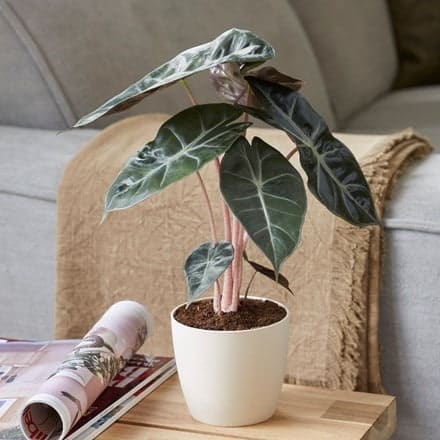Alocasia ‘Pink dragon’ is a colourful species of the Alocasia genus also called Alocasia Baginda Pink Dragon or Elephant Ears Pink Dragon. It is a beautiful and evergreen species that are easy to grow. Although it is now cultivated all over the world, it is native to Asia and East Australia where temperatures are warmer and more humid.

Alocasia Pink Dragon and pot cover
It has deeply lobed, elongated, deep green leaves that are a signature of the alocasia genus but is easily identifiable by the defined venation on its leaves that is reminiscent of a dragon scale and burgundy undersides. More so, it has distinct pink stems, hence its name.
Each leaf has silvery-coloured stems and grows on individual stems. It can reach heights of 8 to 10 feet, but houseplants are small and reach a height of just 4 feet with leaves that spread up to 50 cm.
Growing and Caring For Alocasia Pink Dragon
Alocasia ‘Pink dragon’ is a low-maintenance plant, easy to grow and care for. Without any special care regimen, it can thrive in average room and humidity temperatures.
Propagation is done in spring and summer by dividing the rhizomes. It takes an average of 3 to 6 weeks for the plant to develop.
Growing Conditions
The best growing conditions should mimic the environment of its natural habitat.
- Soil: Organically rich, loose, and well-draining soil is ideal. Creating a porous mix of soil, peat, and perlite is also a great choice to ensure your alocasia pink dragon gets enough nutrients.
- Light: Placing your alocasia ‘pink dragon’ south-facing or west-facing is a great way to supply it with the direct sunlight that it needs for growth. Although it is a sun-lover, exposing it to excessive amounts of direct sunlight will cause leaf scorch.
- Water: It needs regular and heavy watering to keep the soil moist from the depth to the top. It loves moisture but wet and soggy soil will damage the roots. It should not be left to sit in water because that will quickly cause root rot.
- Pruning: Cosmetic pruning should be done in spring and pruning should be avoided during its dormant period.
- Toxicity: Just like all other alocasia species, the pink dragon is a toxic plant to both humans and animals. Though it is not deadly, it can cause unconditional conditions such as swelling of the mouth and tongue, eye irritation, and skin rashes. It should not be ingested and handling with bare hands should be kept at a minimum
- Pests and diseases: They can be attacked by pests such as spider mites, mealybugs, scale, whitefly, and thrips. Common diseases are stem and root rot.
- Temperature and Humidity: Warm humid environments with temperature levels of 18 to 29 degrees Celsius is ideal. The leaves should be misted often to maintain humidity.
Where to buy Alocasia Pink Dragon?

